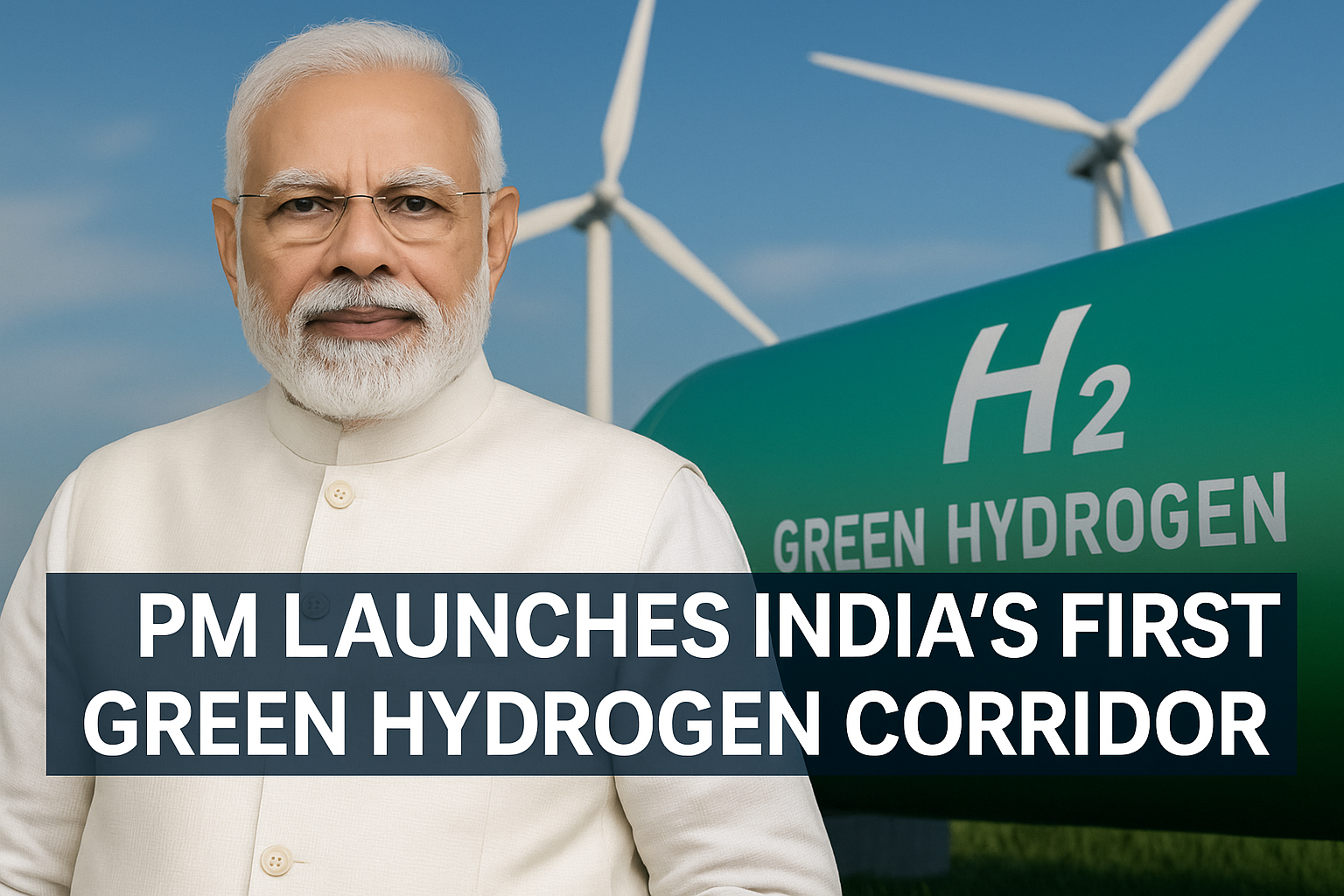
🧭June 14, 2025 Post 3: PM Launches India’s First Green Hydrogen Corridor (Jan 8,2025) | High Quality Mains Essay: Fueling the Future: Green Hydrogen Corridors and India’s Clean Energy Transition | IAS-2026 :Prelims MCQs
PM Launches India’s First Green Hydrogen Corridor

NATIONAL
📅 Post Date: June 14, 2025
📘 Thematic Focus: Energy Transition | Infrastructure | Climate Action
🔋Note: Prime Minister Narendra Modi laid the foundation stone of the country’s first Green Hydrogen Hub Project under the National Green Hydrogen Mission at Pudimadaka near Visakhapatnam in Andhra Pradesh on 8 January 2025. This subject is a potentian question for upcoming IAS Mains.
🌀 Opening Whisper
“When hydrogen turns green, the road ahead lights up with zero‑emission promise.”
🔍 Key Highlights
- Prime Minister inaugurated India’s first Green Hydrogen Corridor near Visakhapatnam under the National Green Hydrogen Mission, marking a historic milestone
- The corridor entails a 20 GW renewable energy capacity designed to produce 1,500 TPD green hydrogen and 7,500 TPD green derivatives (hydrogen derivatives, green methanol, green urea, and SAF) primarily for domestic and export use
- With an investment of approximately ₹1.85 lakh crore, this project supports India’s goal to reach 500 GW non-fossil energy capacity by 2030
- The corridor sets a template for industry‑agriculture synergy, enabling clean fuel for heavy transport, fertiliser production, and export markets, while advancing GS Paper 3 topics on energy infrastructure and climate mitigation.
📘 Concept Explainer: What Is a Green Hydrogen Corridor?
- Green Hydrogen is produced by splitting water via electrolysis using renewable energy sources, making it carbon‐neutral.
- A corridor refers to an integrated production‑to‑end‑use supply chain, including:
- Renewable energy generation (solar/wind)
- Electrolysers
- Storage facilities
- Pipelines and transport hubs
- End-use industrial applications (transport, fertiliser, fuel)
- Such corridors ensure economies of scale, grid balancing, and creation of a clean value chain infrastructure.
🧭 GS Mains Mapping
- GS Paper 3 – Energy Transition: Alternate Fuels, Infrastructure, Climate Change
- GS Paper 2 – Governance’s role in innovation, Climate Financing
- Essay – India at COP28: GHG Mitigation via Green Hydrogen, Infrastructure Scale-up
💭 A Thought Spark — by IAS Monk
“From the sun’s rays and sea breeze, India crafts its clean energy future in hydrogen.”
High Quality Mains Essay For Practice :
Word Limit 1000-1200
Fueling the Future: Green Hydrogen Corridors and India’s Clean Energy Transition
Introduction
In the global quest to decarbonize economies and mitigate climate change, green hydrogen has emerged as a beacon of hope. It is clean, versatile, and scalable—offering a path toward sustainable industrialization, clean mobility, and energy independence. On June 14, 2025, India marked a historic leap by launching its first Green Hydrogen Corridor in Visakhapatnam. This corridor isn’t just an infrastructure project; it’s a visionary step in India’s energy evolution, connecting the promise of renewables to the demands of hard-to-abate sectors like transport, fertilisers, and refining.
This essay explores the significance of the Green Hydrogen Corridor, its link to India’s energy security, implications for sustainable development, and the broader narrative of how hydrogen might fuel a cleaner, greener, and geopolitically resilient India.
What is Green Hydrogen and Why Does It Matter?
Hydrogen is the most abundant element in the universe, but it rarely exists freely. Producing hydrogen typically involves splitting molecules like water (H₂O) or hydrocarbons (like methane). Most hydrogen today is “grey” or “blue,” created using fossil fuels—releasing greenhouse gases in the process.
Green hydrogen, however, is produced by electrolysis of water using renewable energy (solar, wind, hydro), making it truly carbon-neutral.
Its applications span:
- Heavy industries (steel, cement, oil refineries)
- Transport (buses, trucks, trains, ships)
- Power storage (balancing renewable intermittency)
- Fertiliser production (replacing grey hydrogen in urea)
Thus, green hydrogen can decarbonize sectors that electricity alone cannot—earning it the moniker: “the fuel of the future.”
The Corridor Concept: From Vision to Reality
The Green Hydrogen Corridor launched in Andhra Pradesh is a comprehensive, integrated value chain:
- 20 GW renewable energy capacity (solar + offshore wind)
- Electrolyser farms to split water using clean electricity
- 1,500 tons/day hydrogen production capability
- Storage, transport infrastructure (including pipelines and ammonia liquefaction)
- Industrial use hubs for fertilisers, mobility, steel, and refineries
Backed by an ₹1.85 lakh crore public-private investment, it will supply green derivatives like ammonia, methanol, and sustainable aviation fuel (SAF)—both for domestic use and export.
This corridor represents the first step toward India’s goal of producing 5 million tonnes of green hydrogen per year by 2030, under the National Green Hydrogen Mission.
Why India Needs a Hydrogen Push Now
1. Decarbonization of Hard-to-Abate Sectors
Industries such as steel, cement, and fertilisers are responsible for ~30% of India’s emissions and cannot be electrified easily. Green hydrogen is a clean, combustible feedstock—offering an alternative to coal and natural gas.
2. Energy Security & Import Substitution
India imports over 85% of its crude oil and 50% of its LNG. Green hydrogen reduces reliance on volatile fossil fuel imports, while repurposing domestic renewable energy into fuel-grade exports.
3. Renewable Balancing
Excess solar/wind can be used for hydrogen production, solving intermittency problems and storing clean energy in chemical form.
4. Job Creation and Sunrise Economy
The corridor is expected to generate over 2.5 lakh direct jobs and foster innovation in electrolyser manufacturing, fuel cell development, and pipeline infrastructure—key for India’s Make in India and energy tech self-reliance goals.
Challenges on the Road Ahead
Despite its promise, green hydrogen faces considerable barriers:
A. High Production Costs
Green hydrogen costs ₹300–400/kg, compared to grey hydrogen at ₹150/kg. Electrolyser costs, high capital investments, and water-electricity dependencies remain bottlenecks.
B. Infrastructure Gaps
Pipelines for hydrogen transport, high-pressure storage, distribution hubs, and fuelling stations are largely non-existent.
C. Policy and Regulatory Certainty
There’s a need for stable long-term policies on carbon pricing, renewable procurement, open access, and export incentives. Coordination across ministries is essential.
D. Water Scarcity
Electrolysis requires 9 litres of water per kg of hydrogen. In a water-stressed country like India, large-scale production may exacerbate water inequality if not carefully planned.
E. Global Competition and Technology Dependence
China and the EU are rapidly scaling up hydrogen capacity. India must avoid dependency on imported electrolysers and fuel cell technologies, investing in domestic innovation.
Solutions and the Way Forward
1. Domestic Manufacturing Push
PLI (Production Linked Incentive) schemes for electrolysers and fuel cells are already notified. India must also support indigenous R&D and skill development.
2. Blending Mandates
Mandate hydrogen blending into natural gas pipelines and fertiliser production (15–20% by 2030) to stimulate demand and create cost parity.
3. Strategic Hydrogen Hubs
Corridor-style hubs in Gujarat, Maharashtra, Tamil Nadu, and Ladakh should follow Visakhapatnam’s lead. Coastal areas offer access to seawater and export terminals.
4. Green Hydrogen Standards & Certifications
Global export markets require emission traceability. India should develop its own GHG accounting protocols for green hydrogen to be export-compliant.
5. Water-Neutral Electrolysis
Invest in sea water electrolysis, water recycling, and integration with desalination plants to ensure green hydrogen remains environmentally sustainable.
Global Context and Diplomatic Leverage
India is emerging as a climate solutions exporter—and green hydrogen diplomacy is the new frontier. Collaborations with Japan, Germany, UAE, and Australia are already underway.
A strong green hydrogen program enhances India’s position at:
- COP climate negotiations
- G20 and International Solar Alliance
- Global South alliances on sustainable tech
It reflects India’s pivot from being a climate taker to a climate leader.
GS and Essay Relevance
For UPSC aspirants, this development intersects with key syllabus themes:
- GS Paper 3: Energy infrastructure, sustainable development, manufacturing policy
- GS Paper 2: Centre-state coordination, policy formulation, climate governance
- Essay Paper: Topics like “Technology as a Catalyst for Climate Justice” or “India’s Energy Trilemma: Security, Equity, Sustainability”
Conclusion
The Green Hydrogen Corridor launched in June 2025 is not merely a physical structure—it is a symbol of India’s technological optimism, climate responsibility, and industrial innovation. It offers a blueprint for carbon-neutral economic growth, signalling a future where India’s energy needs are met not with imported oil but with sunlight, wind, and innovation.
While challenges persist, the vision is bold and the potential transformative. If India stays the course—balancing ambition with caution, growth with equity—green hydrogen may not just fuel vehicles, but power the nation’s next developmental chapter.
Target IAS-26: Daily MCQs :
📌 Prelims Practice MCQs
Topic: Hydrogen Green Corridor
MCQ 1 – Type 1: How many of the above statements are correct?
Consider the following statements regarding India’s Green Hydrogen Corridor launched in June 2025:
1. It aims to produce over 1,500 tons of green hydrogen daily.
2. The corridor will use natural gas-based reforming as the primary method of hydrogen production.
3. It includes infrastructure for both domestic usage and exports of green derivatives.
4. The corridor is aligned with India’s target of 500 GW non-fossil capacity by 2030.
How many of the above statements are correct?
A) Only one
B) Only two
C) Only three
D) All four
🌀 Didn’t get it? Click here (▸) for the Correct Answer & Explanation
✅ Correct Answer: B) Only three
🧠 Explanation:
•1) ✅ True – 1,500 TPD green hydrogen production is planned.
•2) ❌ False – Green hydrogen uses electrolysis, not natural gas (that would be grey hydrogen).
•3) ✅ True – Green ammonia, methanol, and SAF are included for domestic and export use.
•4) ✅ True – It contributes to India’s 500 GW non-fossil energy target.
MCQ 2 – Type 2: Two Statements Based
Consider the following two statements:
1. Green hydrogen is produced by electrolysing water using fossil-fuel-generated electricity.
2. Green hydrogen can replace grey hydrogen in fertiliser manufacturing and oil refining.
Which of the above statements is/are correct?
A) Only 1 is correct
B) Only 2 is correct
C) Both are correct
D) Neither is correct
🌀 Didn’t get it? Click here (▸) for the Correct Answer & Explanation
✅ Correct Answer: B) Only 2 is correct
🧠 Explanation:
•1) ❌ False – Green hydrogen is produced using renewable energy, not fossil fuels.
•2) ✅ True – Green hydrogen can be used as a clean substitute for grey hydrogen in heavy industries.
MCQ 3 – Type 3: Which of the statements is/are correct?
Which of the following are key benefits or applications of green hydrogen corridors?
1. Fuel for heavy-duty transport and aviation
2. Decarbonisation of the steel and cement industries
3. Energy storage for managing renewable power intermittency
4. Groundwater irrigation through electrolysis recycling
Which of the statements is/are correct?
A) 1, 2 and 3 only
B) 1 and 4 only
C) 2 and 3 only
D) All four
🌀 Didn’t get it? Click here (▸) for the Correct Answer & Explanation
✅ Correct Answer: A) 1, 2 and 3 only
🧠 Explanation:
•1) ✅ True – Green hydrogen is useful for heavy transport and SAF.
•2) ✅ True – Green hydrogen can replace fossil fuels in industrial heat processes.
•3) ✅ True – It allows storing excess solar/wind energy chemically.
•4) ❌ False – Electrolysis consumes water; it’s not directly used for irrigation.
MCQ 4 – Type 4: Direct Fact
Which Indian state hosts the country’s first fully integrated Green Hydrogen Corridor launched in 2025?
A) Gujarat
B) Andhra Pradesh
C) Tamil Nadu
D) Maharashtra
🌀 Didn’t get it? Click here (▸) for the Correct Answer & Explanation.
✅ Correct Answer: B) Andhra Pradesh
🧠 Explanation:
• The first Green Hydrogen Corridor was launched near Visakhapatnam, Andhra Pradesh, as part of the National Green Hydrogen Mission.


















